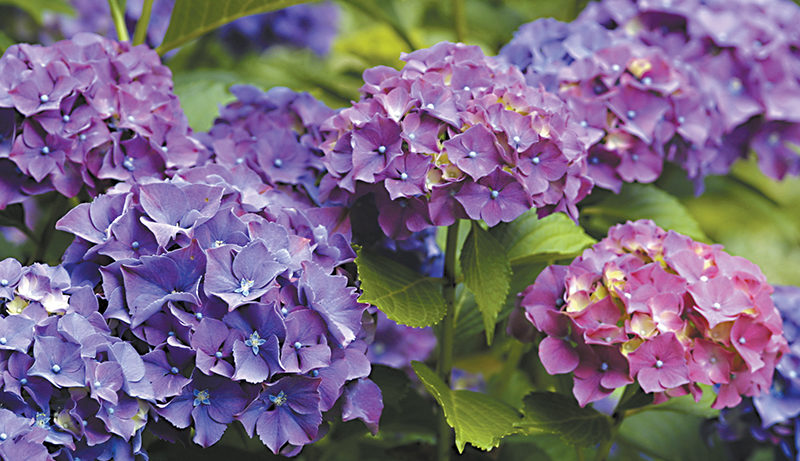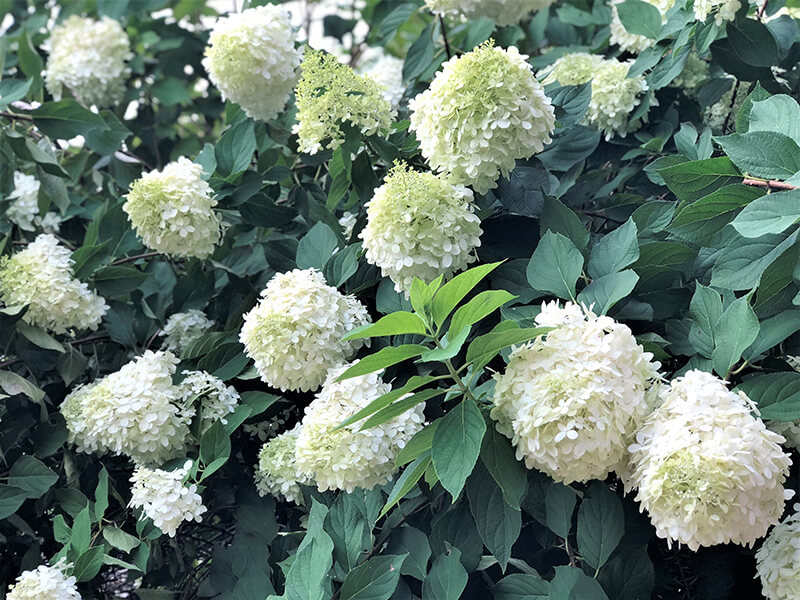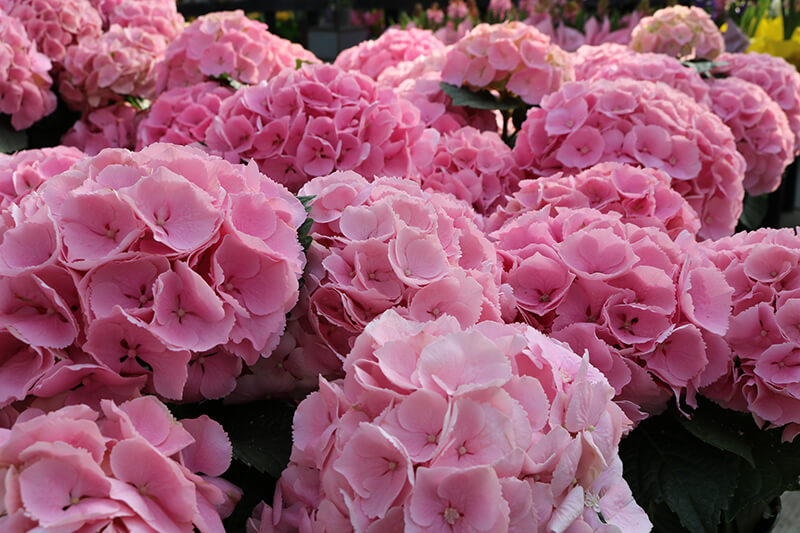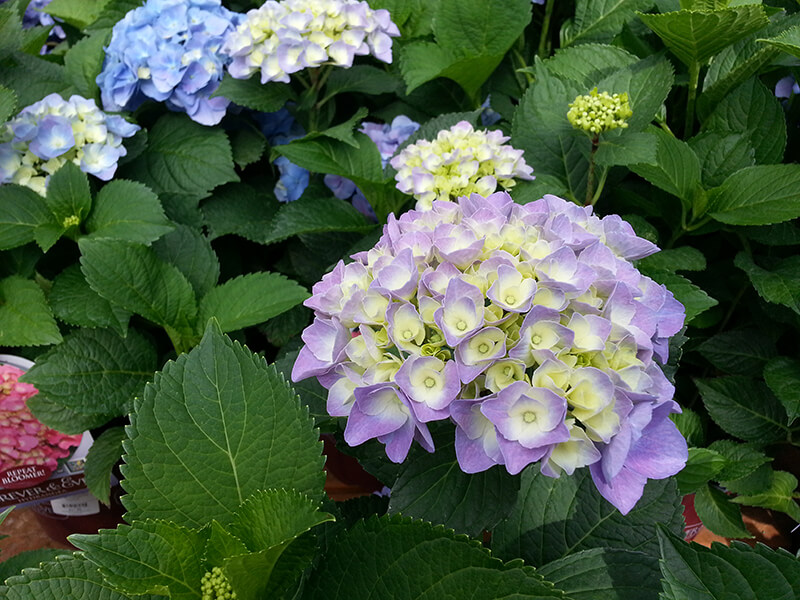Helpful Hydrangea Tips

Hydrangea Care 101
Few flowering shrubs boast as show-stopping a performance in your garden as Hydrangeas. These dominant forces produce beautiful blooms all Summer long that create a dazzling centerpiece, effective privacy screening, and make for fantastic fresh flower bouquets. While countless varieties of Hydrangeas exist with various bloom times, colors, shapes, and sizes, we assembled some essential care tips for you to successfully grow your variety of choice.
Planting Hydrangeas On Your Own
First and foremost, to ensure that your perennial Hydrangea continue to come back year after year with bountiful blooms, you will need to select the proper site where they can establish. Hydrangea require specific soil amenities, exposure, and planting procedures to provide you with that stunning color, so choose your area carefully. They prefer rich soil packed with organic material that delivers excellent drainage and room to grow. The soil should only be somewhat moist, as soggy and poor-draining soils often lead to root rot. If the soil where you want to plant is heavy, consider mixing in compost before planting to enrich it.
As we consider their relationship with sunlight, first know that depending on the climate, Hydrangea can withstand contrasting periods of exposure to the sun. Most species follow the same rule of loving warm morning sun followed by afternoon shade. In northern parts of the country Hydrangea might thrive in full-sun all day, though the further south you go they struggle with prolonged periods of sunlight. We recommend part-shade as the optimal spot for most varieties to produce their best blooms. Always avoid planting beneath trees as they tend to steal the moisture and nutrients from the soil that Hydrangeas need to survive. Full shade also inhibits proper growth.
We recommend Fall followed by early Spring as the best times to plant. Planting in Fall allows your Hydrangea extra time to establish itself in the soil before it’s time to bloom. Avoid the negative effects of high heat by planting close to sunrise or sunset. When preparing to plant, allow ample space for your Hydrangea to reach its full potential. Choose an area on the North or South side near your house to adhere to previously mentioned sunlight needs.
Follow These Hydrangea Planting Steps:
- Dig a hole just deep enough to cover the root ball and 2-3 times as wide as it. By creating a slight mound you can improve drainage.
- Loosen tight root balls before sticking in the ground.
- Fill in halfway around the root ball with soil, then water. Fill in the rest of the way with soil once water drains.
- Water deeply after you surround the root ball.
- Space multiple plants at least 3 to 4 feet apart.

3 Caring Tips for Your Hydrangea After Planting
Next, once planted Hydrangea will need some tender love and care until they are fully established. There are specific ways to water, mulch, and fertilize your perennial to ensure its continued prominence in your garden. Following proper pruning guidelines also leads to a happier, healthier Hydrangea that your neighbors will envy. Let’s discuss these care tips individually:
1. Watering
Above all, after triumphantly planting your Hydrangea you must especially remember to consistently water throughout the first year or two. This particularly applies in times of drought, as leaves will wilt off if soil is left too dry. Once established, Hydrangea should be kept moist, though not wet, at all times. Having rich, well-drained soil is necessary to maintain moisture and avoid becoming overly soggy. Never let your Hydrangea dry out, as it will wilt.
During the growing season, namely Summer, water your shrub thoroughly and often. Provide water deeply roughly 3 times per week at a rate of about 1 inch per week. Do not water the leaves and foliage, as they will burn. As Hydrangea prefer the warm morning sun, we find it beneficial to water in the early morning so that the hot sun does not dry them out. If you notice that your leaves begin to wilt, first try increasing your Hydrangea’s water intake. A simple garden soaker hose will suffice.

2. Fertilizing & Mulching Your Hydrangeas
As stated, there are many different kinds of Hydrangea that benefit from various fertilizer application times. Applying fertilizer does not lead a Hydrangea to bloom, but it does provide important nutrients that maintain the overall health of the plant. Rich soil does not warrant heavy applications, and too much fertilizer for any Hydrangea typically boosts foliage growth at the expense of flowers. Generally speaking, you can use an all-purpose, slow-release or organic fertilizer in Spring or early Summer time. Always water thoroughly before and after application. Do not fertilize in the Fall as your plant should be preparing for dormancy.
Mulch annually around your Hydrangea to retain moisture and keep it cool. Organic mulch will add key nutrients to the soil that benefit your shrub throughout the year. This will also improve soil texture and drainage.
3. Pruning & Potential Problems
Because raising Hydrangea is largely about letting them grow into marvelous spectacles of size and beauty, little pruning is needed. Though certain varieties require specific pruning methods, generally you should only have to remove dead flowers and stems. You can shape up your shrub as well to allow it some room to breathe if it is growing against a structure.
Deadheading can keep your Hydrangea blooming well into Fall. Pruning in abundance leads to fewer blooms but numerous shoots, while less pruning has the opposite effect. Cut dead wood back in early Spring of Fall. Damaged and neglected plants may need all stems pruned back to the base to secure future growth, though this may come at the price of no blooms the following year. After about 5 years, roughly 1/3 of the plant’s living older stems should be cut down to the ground each Summer to encourage new growth.
You may see mildew, blight, gray mold, wilt, rust, and spots on your Hydrangea. Simply fight these conditions by properly caring for you plant. Pests are not a common problem, though might appear on a struggling shrub. You might see aphids and mites, as well as Japanese Beetles on some Oakleaf Hydrangea. See our in-store experts for help with fighting theses pesky pests.

Hydrangea Varieties
Finally, several times throughout these tips we have mentioned that there are tons of varieties of Hydrangea. You can find bloom colors in purple, white, blue, and even pink, red, and lime! In North America, 5 main types line our gardens with beautiful blooms:
- Big Leaf (Mophead, Lacecap, Mountain) – The most common variety found in the United States
- Panicle – Known for cone shaped flower heads and being the most cold-hardy
- Smooth – Tolerate hotter climates
- Oakleaf – The leaves are shaped like those a red oak and are the only Hydrangea leaves to change color in Fall
- Climbing – They are really vines that can grow up structures
Within these types you will find numerous individual varieties with specific traits like the ability to re-bloom and unique color changing abilities. Here are some popular Hydrangeas to consider:
- Bloomstruck®
- Cityline® Berlin
- Endless Summer®
- Forever and Ever
- Invincibelle Ruby – 2020 Hydrangea of the Year
- Limelight
- Little Lime®
- Nantucket Blue
- Peegee
- Ruby Slippers
- Zorro
Whether you are new to caring for Hydrangeas or a gardening expert, our stores have everything you need to be successful at growing your gorgeous shrub. Visit us at any one of our locations and our team members will be happy to assist you with finding the perfect variety or products to help care for them.
Take a look through our Plant Finder to see the stunning varieties available across our locations! See What’s On Sale in our Stores Now.
